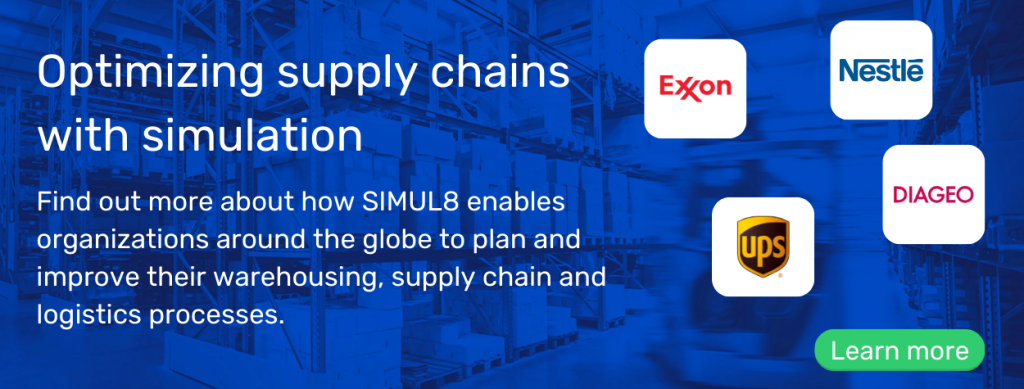Art of Simulation, Latest News
Improving the supply chain: 3 examples of success with simulation
 Andrew Wylie / Jan 9, 2018
Andrew Wylie / Jan 9, 2018
As businesses navigate through the complexities of today’s supply chains, the importance of resilience and adaptability has never been more pronounced. With market conditions more volatile and unpredictable than ever, the questions surrounding the robustness of your supply chain take on new urgency.
How robust is your supply chain? Do you have enough storage capacity to cope with sudden changes in demand or problems with a supplier? What about strategy; could you predict how long an alternative supply route will take to setup?
Simul8’s supply chain simulation software gives you the tools to answer these questions and to test the reliability of your supply chain in a virtual and risk-free environment.
With process simulations we are able to watch the behavior of the supply chain play out over weeks, months or years in just seconds of real-time. Instead of trying out just one strategy, we can easily adjust parameters and re-run our analysis to explore many scenarios; spotting the best opportunities for improvement and uncovering potential risk areas.
So how do we put this into practice and what might your first supply chain simulation project look like? In this post, I’ll share three examples of how Simul8 simulation software has been used on real-world supply chain projects to give you ideas and inspiration for future projects.
If you’d like to learn more about using simulation to guide your own supply chain strategy, get in touch with our team.
1. Dealing with seasons and variability
Winter clothes are four times bigger and heavier than summer outfits; this is something that I learned when developing a simulation with a major clothes retailer.
It was fascinating to me how much influence this simple fact had on the complexity of the supply chain over the winter months; more trucks, more delays, more storage space and even more shopping carts! All of this working on a sliding scale from Miami to Maine, depending on the customer demand for thick winter coats.
Simple models and traditional process improvement tools can be hard to fit to supply chains; a process design that works great for one month may be unsuited for changes that occur just a few weeks later.
As supply chains typically span several organizations and multiple locations, it can be more challenging to communicate and implement improvement strategies, especially when these have a greater vulnerability to external factors such as weather disruption or a shipment being rejected due to quality issues.
Simul8 offers the flexibility to simulate both scheduled regular events (e.g. an increase in customer demand in November or day-to-day truck deliveries) and the ability to use random variation to add out-of-the-ordinary or irregular events (e.g. trucks breakdown, quality problems, staff vacations).
Running your simulation many times, what we call conducting a trial, informs us of the likelihood of outcomes. For example, you might ask ‘what if we’re unlucky and get 20 rainy days in a row, how sensitive would our supply chain be to this?’
Planning for seasonality with simulation – an example
A large furniture manufacturer wanted to improve processes around a range of products where 80% of all customer demand lands in November, due to Thanksgiving and Christmas market influence. In the existing state these products were produced all year long, alongside other product ranges.
The manufacturer wanted to know if investing in a new plant would be beneficial by increasing capacity to allow more production to be focused in the preceding quarter before November (e.g. build all of the stock across 3 months rather than 12 months). This could achieve more Just-in-Time delivery and in turn reduce the dependency on long-term storage of stock.
How did simulation impact supply chain strategy?
Experimenting with historical demand data and process cycle times, the manufacturer used the simulation to verify that a new plant would be beneficial to this objective.
To maximize efficiency, further testing found that setting up the new plant to run six lines offered the best fit for the time frames and productions volumes whilst maintaining an efficiency gain over the traditional storage based system.
After running trials on the new system, where Simul8 automatically performs thousands of runs, an unexpected issue was discovered. The manufacturer discovered that the average increased output rate from the plant in peak months would require twice the amount of trucks over what had been originally estimated as the capacity of the planned haulage facilities.
Catching this early, the design of the plant was adapted to accommodate a larger loading bay; allowing more trucks to load at the same time, rather than waiting. The simulation also confirmed that even with these extra haulage costs the manufacturer would still achieve return on investment.
2. Sizing an opportunity and getting implementation right
Establishing something new in a supply chain can be a challenge. When implementations fail the most common cause is misjudging the sizing of the operation.
Go too small and the system becomes overrun, customers tire of delays and cash flow can be choked. Over-sizing brings other issues; higher investment, under-utilization of staff and equipment (especially during the ramp-up) and the dreaded overspend.
Using simulation mitigates these risks by making it easy to run tests while adding or removing workstations, storage areas or staff. By adjusting and fine-tuning the resource levels in the system you can quickly gain a better understanding of how the process works under pressure and plan for any constraints or extraneous capacity.
Supply chain sizing using simulation – an example
During a large expansion to a European Shipping Port there were many questions that the local government and investors had to examine and answer. Most critically, the sizing of each part of the process needed to be better understood, including how the expansion would need to be supported by local services and infrastructure.
How did the simulation impact supply chain strategy?
Starting by experimenting with the number of ship-to-shore cranes to install, the simulation helped to explore all areas of the dock operations; container movement and storage (including refrigerated storage), loading to trucks and offloading to smaller vessels.
To ensure the economics of the wider initiative, a number of proposed shipping schedules were also tested; some featured conservative estimates with fewer ships and goods, while others tested for more optimistic predictions where the volume of ships and goods were higher but could cause challenges in terms of shipping lanes traffic and a lack of capacity on the road infrastructure.
The impact of the simulation on strategy was two-fold; firstly a clearer established estimate on the minimum viable volume of ships and goods was calculated. This assisted the management team with their business planning and gave more guidance on the amount of supply work that would be needed to support the venture.
Secondly; a particular process was found to be a major constraint in the system: the offloading of large vessels transferring containers to smaller ships. The simulation supported improvements to this process by validating a new ship loading approach that involved sacrificing dockside container capacity to allow faster crane activity.
3. Heijunka, Kanban and Pull Vs Push – levelling supply to demand
How can we really get smarter with our supply chains? One key component is ensuring the right parts get to the right place at the right time.
JIT (Just-In-Time) delivery and other Lean and Six Sigma Process Improvement principles are often discussed but how do we actually go about implementing these to a modern supply chain?
Levelling supply to demand using simulation – an example
A large distribution center used a simulation to understand the optimum lane size and number of lanes to support the product mix and customer demand patterns and avoid stock out occurrences.
How did the simulation impact supply chain strategy?
Distribution centers play a crucial role in the supply chain, acting as a buffer between customer demand and manufacturing output. Sizing them correctly is crucial; reducing stored stock creates capacity for a greater bandwidth of goods, increasing profits, but if we drop volumes too low we risk stock outs that upset the customer.
The simulation confirmed that the parameters for lane size and number of lanes had the most significant influence on performance. From there, they were able to experiment through trial and error to adjust these levels to best match the customer demand profile. The team were able to identify several potential approaches; ranging from more risky to more conservative options, with all options offering improved performance over the current state.
The simulation supported the design of the distribution center and was also a great asset for communicating the supply chain behavior to suppliers and customers. Work on the simulation also opened up discussion on adding a direct channel from one of the manufacturing plants to the consumer and this option is also now being actively explored by expanding the existing simulation.
Enable your stakeholders to get involved in supply chain improvement
By working with Simul8 users on these projects, my take away is that although it can be hard to get everyone on board with a supply chain improvement program, simulation always helps to change this and break out of silo thinking.
There is huge benefit to be found in getting suppliers, customers and managers together in the same room to look at the overall process with an interactive simulation that animates each part of the chain.
Increasingly, we also find that even when teams start off using simulation as a silo tool, exclusively to drive in-house process improvement projects, they quickly realize that sharing their simulations with their customer is a very effective means of communicating with stakeholders and for boosting their bidding process.
One Simul8 user, a tier 1 supplier to the North American automotive industry, explained the benefit of using simulation to me:
“Our normal entry to the bidding process was to submit the same eight page report on the robustness of our production capabilities and we knew that all of our competitors do the same. Now, with a simulation, we can invite the customer to actually test us on that capability and we can demonstrate exactly how we have developed our processes to link to their requirements. The simulation really made us stand out and allowed us to demonstrate our innovation and commitment to continuous process improvement.”
